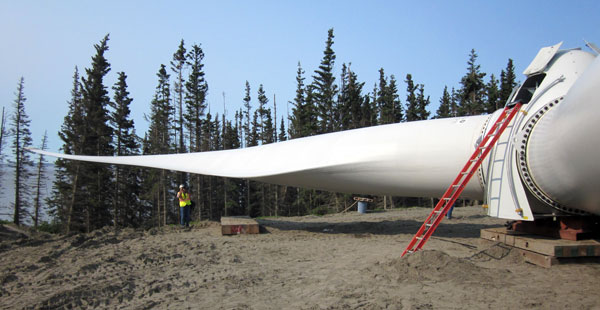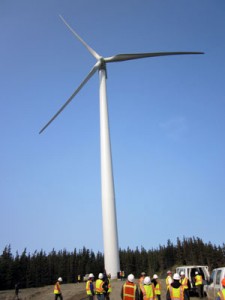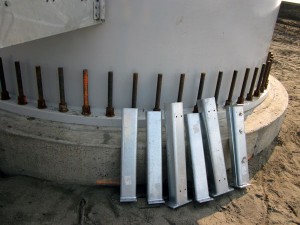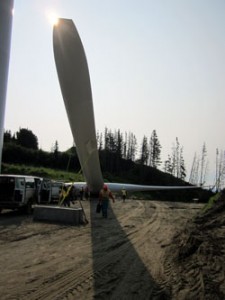
Anchorage’s new wind farm is set to go online by the end of September. When completed, the project, which is being developed by the Cook Inlet Region Incorporated, will provide enough electricity to power 4,000 homes along the rail belt. The transmission line that runs across the inlet is almost done. And this week crews are hoisting the first of 11 wind turbines into place.

If you’ve been on the downtown waterfront lately, you may have seen in the distance, the cranes working across the mud flats on Fire Island. At high tide, the only way to get there is by plane.
Just a few miles across the bay the island comes into sight, hillier and bigger than it appears from the opposite shore, covered in cottonwood, black spruce and devil’s club. Before the Alaska Native Claims Settlement Act, the island belonged to the military. Now CIRI owns most of the island. Today five giant cranes move along its web of gravel roads, lifting giant pieces of wind machines into place.
Workers have already used the cranes to install the 11 turbines that will provide the first source of renewable wind power to Alaska’s largest city. When the blades are up the wind machines are more than a hundred feet taller than the Conoco Phillips building, the tallest building in Anchorage. Each wind machine takes about two months to erect. Scott McManus is supervising this phase of the project.

“Kinda like Lincoln Logs. You just piece ‘em together, bolt ‘em together, tension and torque the bolts and go to the next one,” McManus said.
McManus is with Tetra Tech, a New York-based company that specializes in building wind farms in the Lower 48 and Canada. On Wednesday, around 100 workers were on the island, officials say the majority of them are Alaskans. Construction has gone smoothly, except for occasional visits from bear and moose. When the turbines get spinning, they will provide about 4 percent of the region’s power. That’s not a lot, but it’s a start, says Margie Brown, President and CEO of CIRI.
“We are striving to become an independent power producer with traditional energy resources but also alternative and renewable energy resources not only here in Alaska but here in the Lower 48. And so this is going to be kind of a signature piece for our growing portfolio of energy projects in our subsidiary CIRI Energy,” Brown said.
Photos courtesy of
CIRI is partnering with Chugach Electric on the project. Chugach surveyed Southcentral Alaska for potential wind sites in the 90s and identified Fire Island as the best spot because of strong consistent winds blowing up Turnagain Arm. The winds blow strongest during the winter months, when Southcentral uses the most power and let up when our power use is lowest, in the summer months. Former Legislator Harry Crawford stands below one of the giant turbines looking up. He doesn’t just see a wind machine.
“I can see the power for hundreds of households in this when wind starts those blades to turning. I can see it. I can feel it. It’s just not quite here yet, but it’s comin’,” Crawford said.
Crawford is now a member of the Board of Director’s at Chugach Electric. He says the wind farm on Fire Island is an important first step in stabilizing energy costs along the rail belt.
“As time goes by we’ll pay for these towers and it will be a much cheaper source of power as the cost of gas goes up,” Crawford said.
The towers and on-island infrastructure cost about $65 million to build according to CIRI officials. Right now Chugach power costs, on average, 6 cents per kilowatt hour. Most of that comes from natural gas. At the start the wind power will be 3.7 cents more. But with gas prices expected to rise, alternative energy advocates say, in the long run, it will be a money saver.
“Even though people may say it’s just 4 percent of Chugach’s power, it’s a really important hedge against natural gas prices going up,” Chris Rose, with the Renewable Energy Alaska Project, said.

He says Fire Island wind farm opens the door to other such projects in the region that could further diversify the power grid.
“CIRI, as an independent power producer, is really the first IPP, as they’re called, to operate in the rail belt grid and so I think it is also opening up more competition in the rail belt for other companies to come in and produce renewable energy,” Rose said.
And Rose says for those that are worried about the possibility of the turbines impacting birds, that’s not likely to be a problem. The farm is out of the flyway of migratory birds. The state supplied a $25 million grant to help pay for the power line, which CIRI will eventually hand over to Chugach Electric. Construction was supplemented by a $17 million federal stimulus grant. CIRI has permits to build 30 of the wind turbines, but is starting with 11. They should be feeding into Southcentral’s power grid by fall.
Daysha Eaton is a contributor with the Alaska Public Radio Network.
Daysha Eaton holds a B.A. from Evergreen State College, and a M.A. from the University of Southern California. Daysha got her start in radio at Seattle public radio stations, KPLU and KUOW. Before coming to KBBI, she was the News Director at KYUK in Bethel. She has also worked as the Southcentral Reporter for KSKA in Anchorage.
Daysha's work has appeared on NPR's "Morning Edition" and "All Things Considered", PRI's "The World" and "National Native News". She's happy to take assignments, and to get news tips, which are best sent via email.
Daysha became a journalist because she believes in the power of storytelling. Stories connect us and they help us make sense of our world. They shed light on injustice and they comfort us in troubled times. She got into public broadcasting because it seems to fulfill the intention of the 4th Estate and to most effectively apply the freedom of the press granted to us through the Constitution. She feels that public radio has a special way of moving people emotionally through sound, taking them to remote places, introducing them to people they would not otherwise meet and compelling them to think about issues they might ordinarily overlook.




